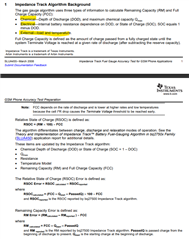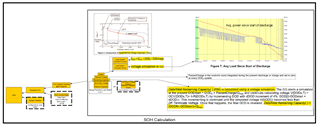Other Parts Discussed in Thread: GPCRA0
Hi
I'm looking for more details on SoH calculation as there is a discrepancy in the derived values from the gauge (BQ34z100-G1). The image below mentions that SOH is the percentage of the ratio of Predicted FCC over the Design Capacity. The design capacity in the application is 10597 (Configured in the gauge) scaled up thrice to 31790mAh the actual Battery Capacity. 
The discrepancy observed here is, the SoH is never 100% and always anywhere between 90% to 95%, even for the fresh battery packs fabricated with 1 or 2 cycles of charging and discharging and this remains the same for 250 cycles and up. With no observed drop in SoH degradation.
The changes on the battery application level is the OV and UV cutoff is earlier, i.e. we are not "using" the full range of the battery capacity during the field operation. And as a matter of fact we are using around 95% of the capacity.
With respect to the above points, please assist with clarification on the following:
1) Why is the SoH value never 100%? Is it related to the on-field battery capacity usage even though the battery health is 100%, the impedance track algorithm calculations disregard the unused capacity in the unused regions of UV and OV?
2) If the above is true, how can the derived SoH value be corrected? e.g. Should the battery be charged and discharged once fully including the the unused capacity in the UV and OV region so that the gauge "reads" actual capacity of the battery and the SoH corrects itself to 100%?
3) How is the Predicted FCC calculated?
NOTE:The learning cycle was successfully completed with the above design capacity and with the same battery configuration and cell chemistry & cell manufacturer. (No changes in the Cell or battery configuration)
Load Mode:1
Load Select:1
Regards
Anvin
P.S. I've tried looking for answers across all the TI's forum and documentation. Looking for more detailed answers.
https://e2e.ti.com/support/power-management-group/power-management/f/power-management-forum/1175682/bq34z100-g1-is-there-guidance-on-soh-calculations?tisearch=e2e-sitesearch&keymatch=BQ34z100%2525252520SoH#
https://e2e.ti.com/support/power-management-group/power-management/f/power-management-forum/1230981/bq34z100-g1-corelating-fcc-and-soh/4669416?tisearch=e2e-sitesearch&keymatch=BQ34z100%20SoH#4669416
https://e2e.ti.com/support/power-management-group/power-management/f/power-management-forum/1270574/bq34z100-g1-state-of-health-capacity-as-batteries-age/4814335?tisearch=e2e-sitesearch&keymatch=BQ34z100%2525252525252520SoH#4814335 slua948 (2).pdfslua455 (1).pdfslua450a (1).pdf
slua948 (2).pdfslua455 (1).pdfslua450a (1).pdf






